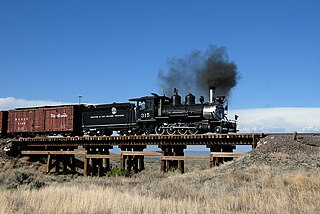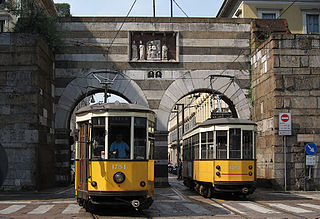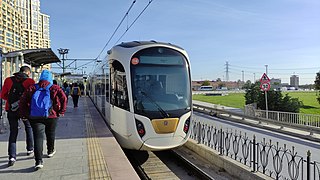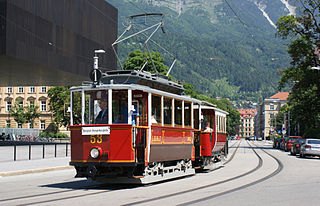
The interurban is a type of electric railway, with tram-like electric self-propelled rail cars which run within and between cities or towns. The term "interurban" is usually used in North America, with other terms used outside it. They were very prevalent in North America between 1900 and 1925 and were used primarily for passenger travel between cities and their surrounding suburban and rural communities. The concept spread to countries such as Japan, the Netherlands, Switzerland, Belgium, Italy and Poland. Interurban as a term encompassed the companies, their infrastructure, their cars that ran on the rails, and their service. In the United States, the early 1900s interurban was a valuable economic institution, when most roads between towns, many town streets were unpaved, and transportation and haulage was by horse-drawn carriages and carts.

Conservation and restoration of rail vehicles aims to preserve historic rail vehicles.

The Sydney tramway network served the inner suburbs of Sydney, Australia, from 1879 until 1961. In its heyday, it was the largest in Australia, the second largest in the Commonwealth of Nations, and one of the largest in the world. The network was heavily worked, with about 1,600 cars in service at any one time at its peak during the 1930s . Patronage peaked in 1945 at 405 million passenger journeys. Its maximum street trackage totalled 291 km in 1923.

Melbourne tram route 86 is operated by Yarra Trams on the Melbourne tram network from Bundoora RMIT to Waterfront City. The 22.2-kilometre (13.8 mi) route is operated out of Preston depot with E class trams.

Trams in Saint Petersburg are a major mode of public transit in the city of Saint Petersburg, Russia. Saint Petersburg once had the second-largest tram network in the world, consisting of about 340 kilometres (210 mi) of unduplicated track in the late 1980s. However, since 1995 the tramway network has declined sharply in size as major portions of track were removed, particularly in the city centre. Saint Petersburg lost its record to Melbourne, Australia. While it still had 285 kilometres (177 mi) of length in 2002, by early 2007 the tram network's had declined to just over 220 kilometres (140 mi), and by the 2010s operated on just 205.5 kilometres (127.7 mi) of network.

Europe has an extensive number of tramway networks. Some of these networks have been upgraded to light rail standards, called Stadtbahn in Germany, premetros in Belgium, sneltram in the Netherlands, trem ligeiro in Portugal and fast trams in some other countries.

The Gråkallen Line is an 8.8-kilometre (5.5 mi) suburban tram line located in Trondheim, Norway. As the only remaining part of the Trondheim Tramway, it runs from the city centre at St. Olav's Gate, via the suburban area Byåsen to Lian. It is designated Line 9, and is served by six Class 8 articulated trams. After the closure of the Arkhangelsk tramway in 2004, it became the world's northernmost tramway system.

The Kyiv Tram is a tram network that serves the Ukrainian capital Kyiv. The system was the first electric tramway in the former Russian Empire and the fourth one in Europe after the Berlin, Budapest, and Prague tramways. The Kyiv Tram system currently consists of 139.9 km (86.9 mi) of the track, including 14 km (8.7 mi) of two Rapid Tram lines, served by 21 routes with the use of 523 tram cars. However, the system is being neglected, the serviced track length is decreasing at a fast rate and is replaced by buses and trolleybuses.

The Trondheim Tramway in Trondheim, Norway, is the world's most northerly tramway system, following the closure and dismantling of the Arkhangelsk tramways in Russia. It consists of one 8.8-km-long line, the Gråkallen Line, running from St. Olav's Gate in the city centre through Byåsen to Lian Station in Bymarka.
The history of trams, streetcars, or trolleys began in the early nineteenth century. It can be divided up into several discrete periods defined by the principal means of motive power used.

The Newcastle Tram System was an extensive network that operated between Newcastle and the outer suburb of Wallsend from 1887 to 1950. At its peak the line extended from the city to Speers Point and West Wallsend. The service was rarely profitable, and low utilisation for a variety of reasons including the convenience of buses led to it closing and the tracks being removed.

The earliest trams in Australia operated in the latter decades of the 19th century, hauled by horses or "steam tram motors". At the turn of the 20th century, propulsion almost universally turned to electrification, although cable trams lingered in Melbourne. In cities and towns that had trams, they were a major part of public transport assets.

The Turku tramway network was the first—and until the 2021 opening of Tampere Light Rail, second to last—tram system to be operated in Finland. It was operated as horse tramway from 1890 until 1892, and as an electrified tramway from 1908 until 1972. Prior to 1919 the tram system was owned by private interests, and from that year onwards by the City of Turku until closure of the system.

The Warsaw tram network is a 125.3-kilometre (77.9 mi) tram system serving a third of Warsaw, Poland, and serving half the city's population. It operates 726 cars, and is the second-largest system in the country. There are about 25 regular lines, forming a part of the city's integrated public transport system organized by the Warsaw Transport Authority. Since 1994 the system is operated by the municipally-owned company Tramwaje Warszawskie sp. z.o.o.

Between 1901 and 1949 Manchester Corporation Tramways was the municipal operator of electric tram services in Manchester, England. At its peak in 1928, the organisation carried 328 million passengers on 953 trams, via 46 routes, along 292 miles (470 km) of track.

The Istanbul Tram is a modern tram system on the European side of Istanbul. The first section, the T1 opened in 1992, followed by the T2, which opened in 2006. In 2011, the T1 and T2 merged, with the line retaining the T1 name. The T4 and the T5 lines followed, opening in 2007 and 2021, respectively.

Trams in Ballarat were first used for public transport in 1887. They ceased to operate as a means of public transport in 1971, but a section continues to be operated today as a tourist attraction.

The Bern tramway network is a network of tramways forming part of the public transport system in Bern, the capital city of Switzerland. In operation since 1890, it presently has five lines, one of which incorporates the Bern–Worb Dorf railway.

Trams in Linz is a network of tramways forming the backbone of the urban public transport system in Linz, which is the capital city of the federal state of Upper Austria in Austria.

The Innsbruck tram network is currently organised over six routes and has a total length of 44 kilometres (27 mi).





















